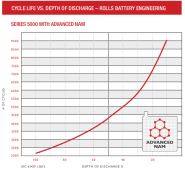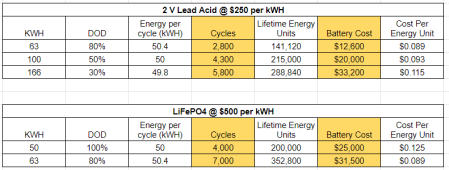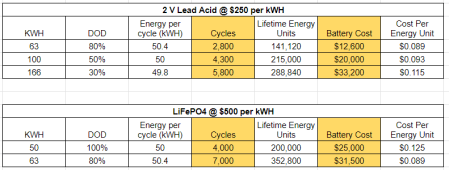Ohms_Cousin
New Member
- Joined
- Nov 6, 2020
- Messages
- 59
Just been hit with a dilemma. Was set to go with LiFePO4 system but have found that the country I am in, has this year (2022) introduced a 10% duty rate and 16% VAT rate on Lithium batteries. Lead acid batteries are duty free and zero rated for VAT (meaning no VAT is charged on them).
I was looking at a fairly big system - somewhere around 250 KWh of capacity in LiFePO4. Not going to happen at these new import tax rates as it adds to much to the cost to import. The system was going to cost a bomb anyway, but now with the new taxes it pushes it over the edge (out of our budget).
So given Lead Acid is "free" to import I have gone back to looking at lead acid. I have been running AGM's for about 12 years now and am on my second set, so I do know about lead acid.
However I would like to have at least 50 kWh of usable lead acid so that means at least 100 kWh of battery capacity. Seems the only thing that makes sense at that size is 2v tubular cells. I dont know much about these cells, so some questions......
If I cycled a 100 kHw battery everyday down to 50% DOD how many cycles could I expect from the batteries ?
It may be better to size the battery slightly bigger and only discharge to 30% DOD - how many cycles would I expect then?
I was really looking forward to 6/7000 cycles out of LiFePO4 (hence why the size system was big - only use 60% of it ie, from 80% to 20%). I realise this is not going to happen with Lead acid but i need at least a few thousand cycles. Is this realistic?
I was looking at a fairly big system - somewhere around 250 KWh of capacity in LiFePO4. Not going to happen at these new import tax rates as it adds to much to the cost to import. The system was going to cost a bomb anyway, but now with the new taxes it pushes it over the edge (out of our budget).
So given Lead Acid is "free" to import I have gone back to looking at lead acid. I have been running AGM's for about 12 years now and am on my second set, so I do know about lead acid.
However I would like to have at least 50 kWh of usable lead acid so that means at least 100 kWh of battery capacity. Seems the only thing that makes sense at that size is 2v tubular cells. I dont know much about these cells, so some questions......
If I cycled a 100 kHw battery everyday down to 50% DOD how many cycles could I expect from the batteries ?
It may be better to size the battery slightly bigger and only discharge to 30% DOD - how many cycles would I expect then?
I was really looking forward to 6/7000 cycles out of LiFePO4 (hence why the size system was big - only use 60% of it ie, from 80% to 20%). I realise this is not going to happen with Lead acid but i need at least a few thousand cycles. Is this realistic?







